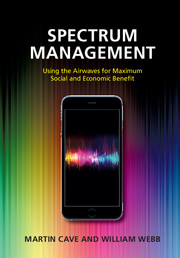Book contents
- Frontmatter
- Contents
- Preface
- Acknowledgments
- Plan of the book
- List of abbreviations
- Part I Fundamentals
- Part II Economic management of spectrum
- 4 Using auctions to assign spectrum
- 5 Other aspects of spectrum auction design
- 6 Spectrum trading
- 7 Spectrum pricing and valuation
- Part III Sharing and other emerging approaches to spectrum management
- Part IV Case studies and conclusions
- About the authors
- Index
- References
5 - Other aspects of spectrum auction design
from Part II - Economic management of spectrum
Published online by Cambridge University Press: 05 November 2015
- Frontmatter
- Contents
- Preface
- Acknowledgments
- Plan of the book
- List of abbreviations
- Part I Fundamentals
- Part II Economic management of spectrum
- 4 Using auctions to assign spectrum
- 5 Other aspects of spectrum auction design
- 6 Spectrum trading
- 7 Spectrum pricing and valuation
- Part III Sharing and other emerging approaches to spectrum management
- Part IV Case studies and conclusions
- About the authors
- Index
- References
Summary
Introduction
In Chapter 4 we examined the economics of spectrum auctions, considered why auctions have become so prevalent, and looked at the good and bad features of a number of auction variants. In this chapter we look at further processes associated with auction design and implementation.
We begin by examining the logistics of an auction. This includes the invitation and pre-qualification stages, and the subsequent grant of a license. The next issue concerns the design of the lots to be used in the spectrum award; these are based on bidders’ needs, the technology likely to be deployed, and the type of auction being used. We then turn to ways of encouraging a competitive auction and the interaction between the design of that auction and competition law. We end by considering the interaction between auctions and downstream competition.
Auction logistics
An auction is one part of a four-stage assignment process:
an invitation stage,
a pre-qualification stage,
an auction stage, and
a grant stage.
These stages follow a sequence, from promoting awareness of the auction among potential bidders (marketing) to the eventual assignment of licenses to successful bidders (the grant stage). This section describes in greater detail each of the stages involved.
The invitation stage
The invitation stage usually comprises the publication of an information memorandum, containing details about all subsequent stages of the auction, application forms and pre-qualification requirements. This stage is an important part of the overall process as it includes the period in which to market the auction. If revenue is an important criterion, then participation will be important.
Pre-qualification stage
The pre-qualification stage in an auction provides an opportunity for the spectrum agency to screen out “inappropriate” bidders and to learn more about likely demand. This is achieved by setting out criteria that must be satisfied by all prospective “appropriate” bidders before they are accepted as participants. In effect a pre-qualification stage is a hurdle to participation. No comparison is made across bidders, distinguishing it from a beauty contest or comparative selection process.
- Type
- Chapter
- Information
- Spectrum ManagementUsing the Airwaves for Maximum Social and Economic Benefit, pp. 94 - 112Publisher: Cambridge University PressPrint publication year: 2015



